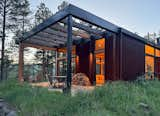10 more photos
Details
Credits
From Veronica Volny
Land and Location
A mosaic of mountain meadows and mature ponderosa forest stretches across thirty-five acres, rising gently to a broad ridge. Below, to the East, Boulder County’s farmlands give way to the Great Plains, which stretch to the horizon. To the West, beyond layers of foothills, rise the gleaming high Rockies–the Continental Divide. And to the South, Boulder’s iconic Flatirons stand in profile before Bear Peak.
There are few locations on Earth that offer such strikingly contrasting yet equally breathtaking perspectives—a view of the sun rising over the prairies, and also of glorious sunsets over the snow-capped peaks. A simple but important consequence of this unusual situation is that the day itself becomes longer; in winter, when much of Boulder falls into a four o'clock shadow, Hill Station still has an hour and a half of sunlight.
The property is large enough, and the house sufficiently isolated from public roads, to feel serene, natural, and wild, yet it is ten minutes from downtown Boulder. Uniquely, the property has two distinct access roads, one leading to Mapleton Hill, a quick jaunt to downtown, the other leading to North Boulder and Newlands. The private road was engineered and constructed to provide comfortable and reliable access while remaining unobtrusive, allowing the landscape around it to return to its full natural beauty.
Architecture and Design
The house is an inspiring and award-winning work of architecture. It has been the subject of various publications, including a feature in Dwell Magazine and an award announcement in the periodical of the American Institute of Architects. Stephen Dynia, the home's architect, has become renowned for such remarkable buildings as the Jackson Hole Performing Arts Center and, in Denver, the innovative Source, Freight, and Taxi buildings.
Bright and airy, the structure affords seamless continuity between interior spaces and the magnificent natural setting. Materials are warm and natural—rusted steel, natural wood—while the lines are elegant and simple. It's a signal example of Modernism meeting the American West. The dwelling is centered around a large, wood-burning oven, with open dining and social space to the south, and simple yet elegant living quarters to the north. A separate studio, two-hundred feet from the house, is perfect for writers, artists, or others who are able to work from home.
In total, the house and studio comprise just under 3,000 square feet of finished floor area. A 500 square foot, two-car garage stands beside the house. A large garden and adjacent chicken coop frame the building envelope. For those drawn to a spectacular natural setting, sophisticated architecture, and a profound synergy between the two, there is no place like this. Sunrise to snowfall, the home shifts with the light.
Living Lightly on the Land
The home was constructed with a deep commitment to land and nature. During the design phase, we retained Rocky Mountain Institute to consult on energy efficiency and sustainability. The home is extremely effective in passive temperature moderation. In winter, the East-facing clerestory and South-facing wall of glass warm the home, while in summer, the remotely operated exterior shades on the East side and large overhang on the West side keep out excess sun. Having an in-tact and healthy forest, with clear view-corridors to the divide, rather than full clear-cut exposure, is perhaps the most important element for sustainable comfort.
Commitment to nature influenced not only the home's footprint and design, but also choices about energy provision. The home offers full net-zero potential with the ease and convenience of municipal utilities. A large solar array stands along the road. For those interested in heating with the land's abundant supply of wood, there is a Danish wood-burning stove in the living room, as well as a unique wood-fired boiler in the basement utility room—it feeds into the radiant heating system that warms the home's floors. Whether you're stoking the fire or just relying on the high-efficiency boiler, the house stays perfectly warm.
Whereas many large mountain properties rely on deep wells for water, propane for gas, and suspended cables for electricity, Hill Station has water, gas, and electrical lines that run under the private road, ascending from Pine Brook Hills. Electricity is provided by a large solar array that stands along the private road. The array and house are connected to the grid. There is an EV-charger in the garage. Finally, a large buried cistern retains rainwater from the roof and returns it to the landscape in hot dry times, when it’s needed.



















